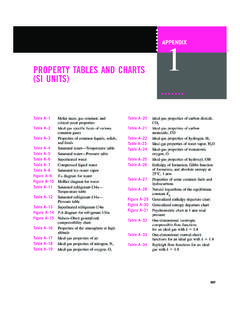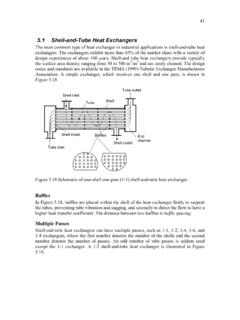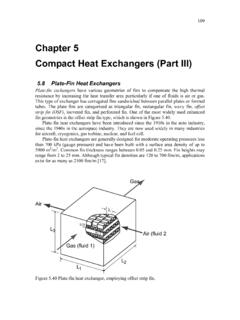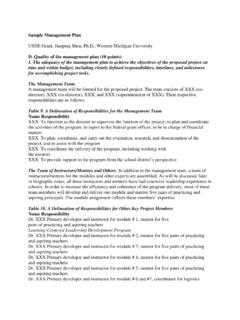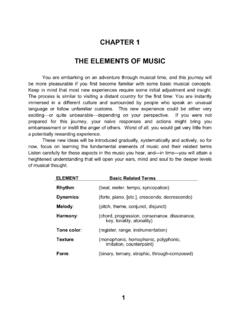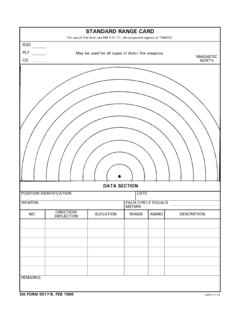Transcription of The Physics of Sound - Western Michigan University
1 The Physics of Sound 1 The Physics of Sound Sound lies at the very center of speech communication. A Sound wave is both the end product of the speech production mechanism and the primary source of raw material used by the listener to recover the speaker's message. Because of the central role played by Sound in speech communication, it is important to have a good understanding of how Sound is produced, modified, and measured. The purpose of this chapter will be to review some basic principles underlying the Physics of Sound , with a particular focus on two ideas that play an especially important role in both speech and hearing: the concept of the spectrum and acoustic filtering. The speech production mechanism is a kind of assembly line that operates by generating some relatively simple sounds consisting of various combinations of buzzes, hisses, and pops, and then filtering those sounds by making a number of fine adjustments to the tongue, lips, jaw, soft palate, and other articulators.
2 We will also see that a crucial step at the receiving end occurs when the ear breaks this complex Sound into its individual frequency components in much the same way that a prism breaks white light into components of different optical frequencies. Before getting into these ideas it is first necessary to cover the basic principles of vibration and Sound propagation. Sound and Vibration A Sound wave is an air pressure disturbance that results from vibration. The vibration can come from a tuning fork, a guitar string, the column of air in an organ pipe, the head (or rim) of a snare drum, steam escaping from a radiator, the reed on a clarinet, the diaphragm of a loudspeaker, the vocal cords, or virtually anything that vibrates in a frequency range that is audible to a listener (roughly 20 to 20,000 cycles per second for humans). The two conditions that are required for the generation of a Sound wave are a vibratory disturbance and an elastic medium, the most familiar of which is air.
3 We will begin by describing the characteristics of vibrating objects, and then see what happens when vibratory motion occurs in an elastic medium such as air. We can begin by examining a simple vibrating object such as the one shown in Figure 3-1. If we set this object into vibration by tapping it from the bottom, the bar will begin an upward and downward oscillation until the internal resistance of the bar causes the vibration to cease. The graph to the right of Figure 3-1 is a visual representation of the upward and downward motion of the bar. To see how this graph is created, imagine that we use a strobe light to take a series of snapshots of the bar as it vibrates up and down. For each snapshot, we measure the instantaneous displacement of the bar, which is the difference between the position of the bar at the split second that the snapshot is taken and the position of the bar at rest. The rest position of the bar is arbitrarily given a displacement of zero; positive numbers are used for displacements above the rest position, and negative numbers are used for displacements below the rest position.
4 So, the first snapshot, taken just as the bar is struck, will show an instantaneous displacement of zero; the next snapshot will show a small positive displacement, the next will show a somewhat larger positive displacement, and so on. The pattern that is traced out has a very specific shape to it. The type of vibratory motion that is produced by a simple vibratory system of this kind is called simple harmonic motion or uniform circular motion, and the pattern that is traced out in the graph is called a sine wave or a sinusoid. Figure 3-1. A bar is fixed at one and is set into vibration by tapping it from the bottom. Imagine that a strobe light is used to take a series of snapshots of the bar as it vibrates up and down. At each snapshot the instantaneous displacement of the bar is measured. Instantaneous displacement is the distance between the rest position of the bar (defined as zero displacement) and its position at any particular instant in time.
5 Positive numbers signify displacements that are above the rest position, while negative numbers signify displacements that are below the rest position. The vibratory pattern that is traced out when the sequence of displacements is graphed is called a sinusoid. The Physics of Sound 2 Basic Terminology We are now in a position to define some of the basic terminology that applies to sinusoidal vibration. periodic: The vibratory pattern in Figure 3-1, and the waveform that is shown in the graph, are examples of periodic vibration, which simply means that there is a pattern that repeats itself over time. cycle: Cycle refers to one repetition of the pattern. The instantaneous displacement waveform in Figure 3-1 shows four cycles, or four repetitions of the pattern. period: Period is the time required to complete one cycle of vibration. For example, if 20 cycles are completed in 1 second, the period is 1/20th of a second (s), or s.
6 For speech applications, the most commonly used unit of measurement for period is the millisecond (ms): 1 ms = 1/1,000 s = s = 10-3 s A somewhat less commonly used unit is the microsecond ( s): 1 s = 1/1,000,000 s = s = 10-6 s frequency: Frequency is defined as the number of cycles completed in one second. The unit of measurement for frequency is hertz (Hz), and it is fully synonymous the older and more straightforward term cycles per second (cps). Conceptually, frequency is simply the rate of vibration. The most crucial function of the auditory system is to serve as a frequency analyzer a system that determines how much energy is present at different signal frequencies. Consequently, frequency is the single most important concept in hearing science. The formula for frequency is: f = 1/t, where: f = frequency in Hz t = period in seconds So, for a period s: f = 1/t = 1 = 20 Hz It is important to note that period must be represented in seconds in order to get the answer to come out in cycles per second, or Hz.
7 If the period is represented in milliseconds, which is very often the case, the period first has to be converted from milliseconds into seconds by shifting the decimal point three places to the left. For example, for a period of 10 ms: f = 1/10 ms = 1 s = 100 Hz Similarly, for a period of 100 s: f = 1/100 s = 1 s = 10,000 Hz The period can also be calculated if the frequency is known. Since period and frequency are inversely related, t = 1/f. So, for a 200 Hz frequency, t = 1/200 = s = 5 ms. Characteristics of Simple Vibratory Systems Simple vibratory systems of this kind can differ from one another in just three dimensions: frequency, amplitude, and phase. Figure 3-2 shows examples of signals that differ in frequency. The term amplitude is a bit different from the other terms that have been discussed thus far, such as force and pressure. As we saw in the last chapter, terms such as force and pressure have quite specific definitions as various combinations of the basic dimensions of mass, time, and distance.
8 Amplitude, on the other hand, will be used in this text as a generic term meaning "how much." How much what? The term amplitude can be used to refer to the magnitude of displacement, the magnitude of an air pressure disturbance, the magnitude of a force, the magnitude of power, and so on. In the The Physics of Sound 3 05101520253035404550-10-50510 Time (ms) Instantaneous Amp. -10-50510 Instantaneous Amp. present context, the term amplitude refers to the magnitude of the displacement pattern. Figure 3-3 shows two displacement waveforms that differ in amplitude. Although the concept of amplitude is as straightforward as the two waveforms shown in the figure suggest, measuring amplitude is not as simple as it might seem. The reason is that the instantaneous amplitude of the waveform (in this case, the displacement of the object at a particular split second in time) is constantly changing. There are many ways to measure amplitude, but a very simple method called peak-to-peak amplitude will serve our purposes well enough.
9 Peak-to-peak amplitude is simply the difference in amplitude between the maximum positive and maximum negative peaks in the signal. For example, the bottom panel in Figure 3-3 has a peak-to-peak amplitude of 10 cm, and the top panel has a peak-to-peak amplitude of 20 cm. Figure 3-4 shows several signals that are identical in frequency and amplitude, but differ from one another in phase. The waveform labeled 0o phase would be produced if the bar were set into vibration by tapping it from the bottom. The waveform labeled 180o phase would be produced if the bar were set into vibration by tapping it from the top, so that the initial movement of the bar was downward rather than upward. The waveforms labeled 90o phase and 270o phase would be produced if the bar were set into vibration by pulling the bar to maximum displacement and letting go -- beginning at maximum positive displacement for 90o phase, and beginning at maximum negative displacement for 270o phase.
10 So, the various vibratory patterns shown in Figure 3-4 are identical except with respect to phase; that is, they begin at different points in the vibratory cycle. As can be seen in Figure 3-5, the system for representing phase in degrees treats one cycle of the waveform as a circle; that is, one cycle equals 360o. For example, a waveform that begins at zero displacement and shows its initial movement upward has a phase of 0o, a waveform that begins at maximum positive displacement and shows its initial movement downward has a phase of 90o, and so on. Figure 3-2. Two vibratory patterns that differ in frequency. The panel on top is higher in frequency than the panel on bottom. The Physics of Sound 4 05101520253035404550-10-50510 Time (ms) Instantaneous Amp. -10-50510 Instantaneous Amp. Figure 3-3. Two vibratory patterns that differ in amplitude. The panel on top is higher in amplitude than the panel on bottom. Phase: 0 Phase: 90 Phase: 180 Phase: 270 Figure 3-4.


